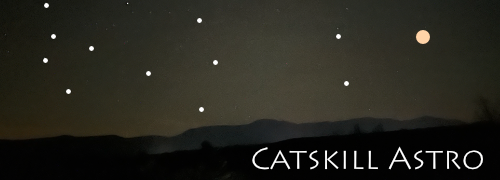Messier Objects
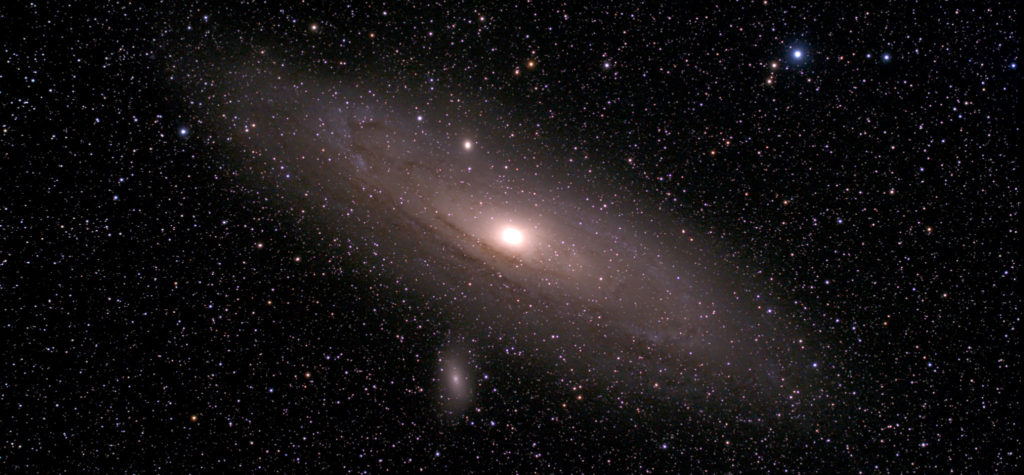
Page 3 of 11
Messier observations 21-30 of 110 total to date.
| Catalog # | Thumbnail | Title/link | Description |
|---|---|---|---|
| M21 | 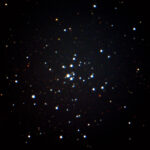 |
M21 / NGC 6531 | This small, open cluster was discovered by Messier (ninth object overall) and was recorded on July 5, 1764. <--> M21 is a tiny open cluster located next to the Trifid Nebula (M20, see annotated view in gallery) on the edge of the rich Sagittarius star-field.. This is one of those objects of interest to Messier creating a list of "not comets" but has little visual interest to me except in combination with other objects or background. The gallery offers three views: 1) The principal image is a narrow field view captured with my EdgeHD. It shows the details of cluster well, but none of the context. 2) a more recent medium-field image captured with my Seestar. It shows the dark nebula and star field much more clearly. 3) A wide-field view showing M21 and M20 in context. |
| M22 | 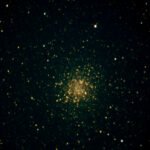 |
M22 / Great Sagittarius Cluster / NGC 6656 | This is the first Globular Cluster of any description noted in the astronomical literature, discovered by Abraham Ihle in 1665. It was cataloged by Messier on June 5, 1764. Messier records, "This nebula is round, it doesn't contain any star, & one can see it very well in an ordinary telescope of 3.5-foot [FL]." <--> M22 is ranked number 1 and 2 among all Messier GCs for brightness and size, respectively. This is also, for me personally, the oldest EAA observation in this list, captured 2 weeks after I successfully connected my camera to SharpCap running in a laptop and captured a snapshot of Jupiter. I have only a vague recollection of this observation. I was using 4s exposures at 285 gain observing on an unstable deck. I no longer have access to the original imagery so did not attempt to re-process. And it's clear that this capture doesn't do M22 justice. However, I enjoy preserving it as a milestone in my personal observing history. |
| M23 | 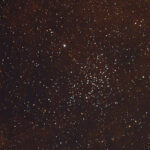 |
M23 / NGC 6494 | This open cluster was discovered by Messier himself (#10) and cataloged on June 20, 1764. It continues his exploration of the southern sky in the area of Sagittarius, but now at a higher declination. Presumably, in the 18th century the star field would have been visible even from Paris, given limited light pollution. Messier's notation makes it clear that his telescope could resolve these stars: "The stars of this cluster are very close to one another." <--> This is one of my favorite OCs, significantly because of its background which contains a dense cloud of stars mottled by dark nebulae. In addition while the annotation makes it clear that the boundaries of the cluster are fairly small circle (Messier's FOV being pretty narrow), the overall star grouping is much larger and more interesting, appearing like a goose with wings spread wide. I've included an earlier observation of M23 in the gallery, captured with my EdgeHD. |
| M24 | 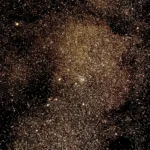 |
M24 / Small Sagittarius Star Cloud / NGC 6603 | Messier recorded this discovery (#11) two weeks after M21 on June 20, 1764: it describes both a cluster "on the parallel of the proceeding [M23]" and "a large nebulosity in which there are many stars of different magnitudes: the light which is spread throughout this cluster is divided into several parts". <--> We're viewing portions of the Milky Way star cloud as it is alternately framed and obscured by dark nebulae (dust). In many ways, it's the most dramatic demonstration of the immensity of the Milky Way and for me personally is a favorite object. While Messier continues his movement to higher declination's, from the Catskill region, I can get very little time on this target given how low it is on my horizon. When I started this capture the left side was actually in the trees. In the gallery you'll see an earlier image centered on the small, open cluster NGC 6603 taken with my EdgeHD. |
| M25 |  |
M25 / IC 4725 | Continuing Mesisier's exploration in Sagittarius, on June 20, 1764 he recorded, "A cluster of small stars in the neighborhood of the two previous clusters [M23/M24]." Originally observed by de Chéseaux in 1745-46, and others including Bode (1777) and Herschel himself (1783) it [in error?] was omitted from Herschel's General Catalog, and therefore did not receive NGC listing. <--> This strikes me as a typical open cluster on top of an atypical star field that's part of the Milky Way. |
| M26 | 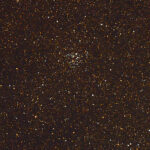 |
M26 / NGC 6694 | The last of 3 entries on June 20, 1764, this was Messier's own discovery (#12), and a tiny cluster in Scutum. <--> This featured image is from March 2025 in good, pre-dawn conditions. M26 contains at least one red giant but most of this not-terribly-dense cluster is made up of blue stars. It is really overshadowed by its context in the sky. I had performed a much less effective capture in May of 2024 using my EdgeHD which could not resolve the background given the poor conditions, angle, and slow optics. This was one of the first Messier objects I'd captured below the celestial equator, and is located on the edge of a whole series of Messier objects which are even further below the equator, defining what is probably the most challenging part of my quest to image all of the objects. M26 is high enough not to be overly challenging, but was foreshadowing challenges to come. I've included an image from the EdgeHD in the Gallery. The combination of faster optics and reduced image scale with the Askar means the background was easily resolved in a brief capture. |
| M27 | 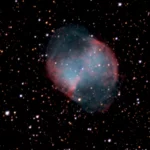 |
M27 / Dumbbell Nebula / NGC 6853 | Discovered by Messier himself (#13), recorded on July 12, 1764, "it appears of oval shape, & it contains no star". <--> This is a huge, very bright planetary nebula: the first in the Messier Catalog and possibly the first ever recorded. Of course, there IS a tiny central star, a white dwarf, which shed the material now ionized as the planetary disk as well as lanes of red dust within the envelope. Field Stars are misshapen arguing for wind or poor seeing. |
| M28 |  |
M28 / NGC 6626 | Discovered by Messier himself (#14) on July 27, 1764: "It contains no star; it is round, it can only be seen difficultly with an ordinary telescope of 3.5-foot [FL]". <--> M28 is ranked 14 and 18 in terms of brightness and size, respectively, out of the 29 Messier GCs. The core has a decided pentagram-like appearance, and appears to have an extended halo of stars that are not counted as part of the object. I note that the Astrometry.com annotation draws the boundary as pretty much the points of the pentagram. This is a very challenging object for me to observe because it stays under 24° at its peak, at a point (due south) where trees obscure almost 30°. I have a small window to the SE, where my horizon falls below 20°. I was able to take advantage of it, briefly, here. At such a low elevation, clouds along the line of sight can readily obscure the capture, and so it happened. At nearly 2 AM, I was pleased to be able to capture anything. |
| M29 | 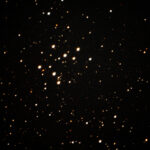 |
M29 / NGC 6913 | Discovered by Messier himself (#15) and recorded on July 29, 1764, noting: "A cluster of 7 or 8 very small stars, which are below Gamma Cygni." <--> Sometimes I think the Messier Catalog has morphed into a "brand" that's out of touch with it reality. Yes, it's the oldest catalog, and some of the most beautiful, and bright, DSOs are listed in it. But this hides a larger truth that Messier was, to a significant degree, creating a list of places that he DIDN'T want to observe. He recorded them so he could eliminate them as "not comets" when trying to spot a new one. M29 seems to be one of those objects. Frankly, except for the fact that this cluster is in the Messier Catalog, I would never choose to observe it. That it kept me awake past 1 AM on a crazy night with a nearly full moon and multiple layers of clouds makes it worse. Sigh. Do I sound bitter? Not really. But it's one of those unintended consequences of taking on a challenge like "observe every Messier Object". |
| M30 | 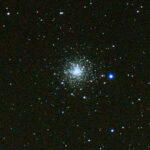 |
M30 / Jellyfish Cluster | Messier discovered this object himself (#16), recording it on August 3, 1764, noting, "It is round & contains no star". <--> Rated 15 and 16 among all Messier GCs for brightness and size, this is the first GC in the catalog that is below the median on both dimensions. Unusually for a GC, there are multiple, linear star patterns extending from the core, and extending well away from the core, giving it a distinctive appearance (presumably triggering the jellyfish nickname). While some "tendrils" appear to be red-giants, other lines are dominated by tiny blue stars. These are apparently newly formed out of energy derived from near collisions of older stars in the core. I was a few weeks late capturing this target, and it JUST clears the trees on my home, southern horizon. I'd forgotten that it was missing and fortunate I could point the Seestar at it when I realized it was still visible. |
